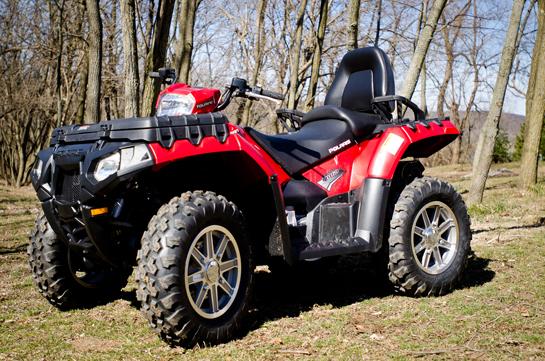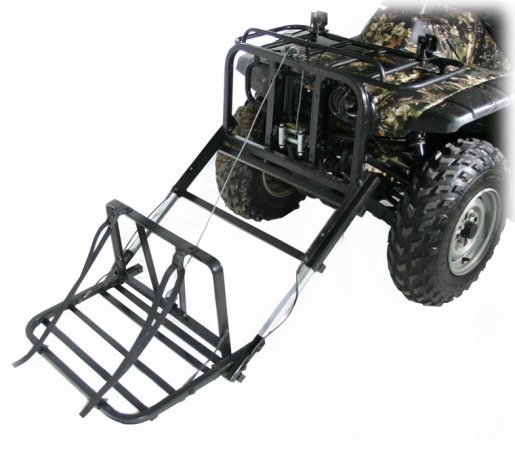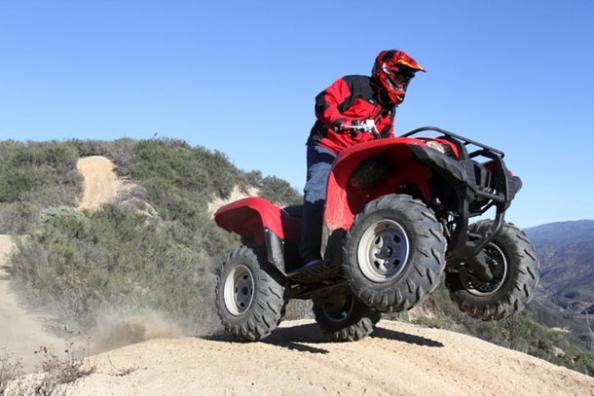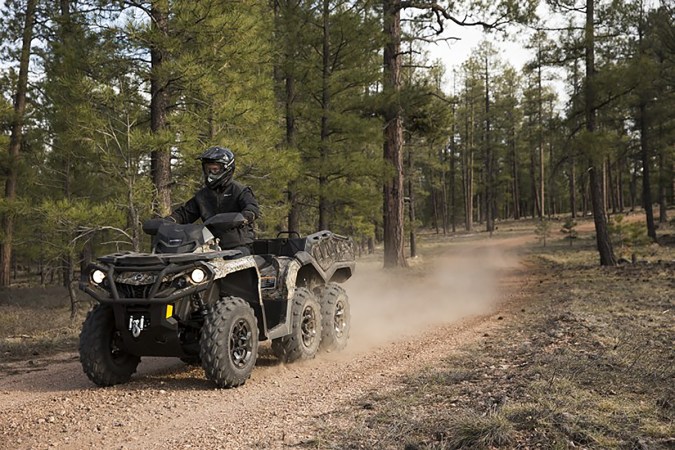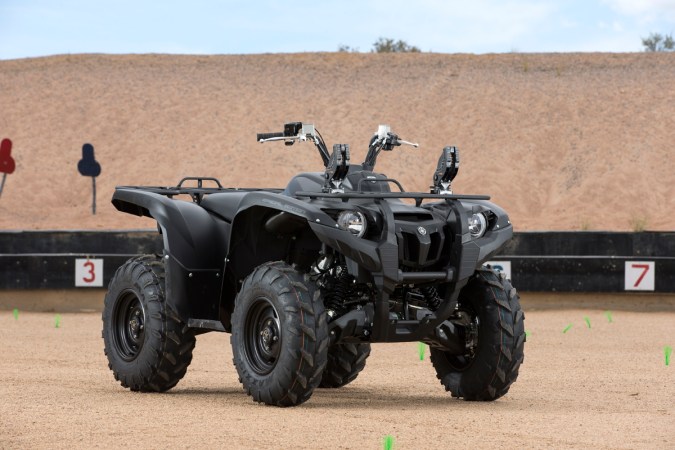We may earn revenue from the products available on this page and participate in affiliate programs. Learn More ›
by Lance Schwartz
__
Machine: 2012 Can Am Outlander 1000 XT
MSRP: $11,949 -Yellow/Black $12,349 – Camo/Pure Magnesium Metallic
www.canamoffroad.com
Over the last few months, I’ve logged nearly 300 miles testing Can Am’s new Outlander 1000 XT in the rocky, muddy, densely forested terrain of Pennsylvania’s anthracite coal region. The time spent riding the Outlander gave me a clear perception of how the machine performed in nearly every situation a typical rider would subject it to. The takeaway? This is the best ATV the company has ever produced.

What makes it so good? The updates to the new Outlander 1000 XT are both evolutionary and revolutionary, but the most obvious change is to the engine. Past Outlander models featured engines ranging from 400 to 800cc. But with other manufacturers bumping engine size above 800cc, and after the successful launch of the Can Am Commander 1000 Side-by-Side in 2011, it made sense for Can Am to transplant the Commander’s massive 1000cc power plant into a new, mega-bore ATV.
After the dust and mud settled, I was left with one impression: the Outlander1000 XT is not only the best ATV Can Am has ever built, it could very well be the litmus test upon which all other ATV’s in the industry are compared.

Engine/Transmission/Drivetrain:
**Key Features: **
• 82 Horsepower Rotax Engine: This fuel injected, 976cc V-twin, liquid-cooled, eight-valve, single overhead cam is the most powerful engine available in a production ATV.
• CVT transmission: The Can Am CVT (Continuously Variable Transmission) features an electronic engine brake designed to mimic the compression braking that occurs naturally in manual transmissions.
• Visco-Lok† QE (Quicker Engaging) front differential: automatically locks/unlocks both front wheels when needed, allowing me to concentrate on clawing my way out of a murky quagmire rather than deciding whether or not I should lock the differential.
• New airbox: This is mounted higher in the chassis and redesigned to flow more air than in older Outlanders. Air filter can also now be changed without tools.
PERFORMANCE:
You could be forgiven for thinking that, at eighty-two horsepower, this beast of an ATV would be a handful to ride, but the Outlander 1000 XT was surprisingly easy to handle at low speeds. I putted around my property, gently carrying a load on the racks and timidly towing a 1000-pound landscape trailer and never felt out of control. On the other hand, I could absolutely terrorize the terrain and rip down the trail at speeds in excess of 75mph with finesse. It’s tough to design an all-purpose ATV with this level of capability and refinement on both ends of the spectrum, but Can Am has accomplished the task. Inexperienced riders certainly need to respect the power and performance this ATV is capable of delivering, or they’ll risk the possibility of getting into trouble quickly.
The hero here is the Outlander’s CVT transmission, which does an excellent job of harnessing the powerful engine. Were it not for the CVT being clutched properly, it would be tough to ride this much power in such a civilized manner.
HITS & MISSES:
HITS:
• Massive power, yet civilized enough to ride at slow speeds
• Fuel injection provides crisp throttle response and painless starts
• Visco-Lok† QE (Quicker Engagement) engages automatically when needed
MISSES:
• Gear selector feels clunky, making gear changes more difficult than it should be.
• With 82hp, it’s easy to smoke the CVT belt when towing a load without choosing low gear.

Chassis/Suspension:
Key Features:
• G2 SST Chassis: Can Am’s Surrounding Spar Technology chassis gets major revisions, making it stronger, better handling, and capable of withstanding the force of 82 horsepower.
• TTi Rear Suspension: Features a “Torsional Trailing arm” similar to the rear suspension on a desert racing truck. This means the wheel pivots in an up and down motion rather than in an arc, as it does in more typical a-arm suspensions. This eliminates scrub — the wheel’s tendency to move left and right as it cycles up and down.

• Tri Mode DPS (Dynamic Power Steering): Features low, medium, and maximum modes that can be adjusted on the fly with the rider’s left thumb.
PERFORMANCE:
The new G2 SST chassis gives this Outlander a more tame front end that dives less during breaking and sharp turns. The new suspension provides a plush ride at slow speeds, with enough compression and rebound dampening to take on the hard hits an aggressive rider on a gnarly trail can dish out. The rear sway bar limits undesirable body roll in most situations. However, while cornering aggressively and then getting off the throttle, the front shocks permit the front end to roll towards the outer front tire, lifting the inner rear tire. Adding more preload to the adjustable front springs helps improves the situation, but even at the highest setting, I was able to lift a rear wheel often.
The Tri Mode DPS is phenomenal. With the simple push of a button, the level of power steering assist can be adjusted on the fly. The DPS also mimics a steering stabilizer by deflecting unwanted handlebar feedback after impacting rocks, stumps, roots, and ruts.
**
HITS & MISSES:**
**HITS: **
• The SST G2 chassis is much more refined and better handling than previous generation models.
• The Tri-Mode DPS is so good, it surprises me other manufacturers don’t offer it.
MISSES:
• To provide a plush ride, the front suspension is soft. Aggressive riders will easily bottom out the front suspension long before they bottom the rear.
• The design of the TTi rear suspension leaves the rear axles more vulnerable to damage than a typical a-arm Independent Rear Suspension (IRS).
**
Ergonomics:**
KEY FEATURES:
• Tri-Mode DPS (Dynamic Power Steering): Power steering selector button is accessible even at high speeds in rough terrain.
• LinQ System Racks: Their low profile prevents aggressive riders from impacting the racks during aggressive riding. Compatible with Can Am’s LinQ rack accessories.
• Hydraulic Disc Brakes: Dual, ventilated front discs and a single rear disc are actuated simultaneously by a single lever, rather than having to grab a separate front brake lever or stepping on a floorboard mounted rear brake pedal.
• 5.7-gallon rear storage trunk: Water resistant and large enough to house a small air compressor, which frees up rack space to haul other loads.

PERFORMANCE:
One of my favorite features on this Outlander is the Tri-Mode DPS. Having adjustable power steering is great, but being able to cycle through the three settings without needing to stop is genius. I experimented with the DPS button constantly, and it’s easy to feel the different settings take effect.
At 6’2″, my long legs were the perfect length to land my tender hindquarters on the previous generation Outlander rear rack dozens of times. The Outlander 1000XT fixes that with the new LinQ System rack that has a much lower profile that’s much kinder to my tailbone.
While trying to get the Outlander stuck, I dunked it into a murky pit with a water depth that nearly reached the seat. The exhaust gurgled like an outboard motor and with the Visco-Lok automatically engaged, the Outlander clawed its way out the other end. The mud worthiness is unquestionable. However, that experiment taught me that the “water resistant” rear trunk is not “waterproof”.
The single lever braking works nicely in combination with large disc brakes, both front and rear. Although I’ve gotten used to riding single-levered machines, my preference is still to have separate control over the front and rear brakes. Riders do have the ability to brake the rear wheels separate from the front via a foot brake, but there is no separate front brake.

HITS & MISSES:
**HITS: **
• Tri-Mode selector on left thumb
• Rear rack profile is excellent and far superior to the previous rack design.
MISSES:
• An ATV with this much performance should have separate front and rear brake levers.
• Winch remote cable is stowed in the rear trunk, which is not waterproof.

Fit/Finish:
**Key Features **
• New Bodywork: Slick looking plastic bodywork is available in Yellow, Black, Camo, and Pure Magnesium Metallic.
• Hand guards: Standard on XT models, they provide protection from branches and flying debris, while also helping to keep hands warm during winter riding.
• Front and rear bumpers: standard on XT models, the bumpers protect the bow and stern from light impacts with trail obstacles.
• 3000-Pound Warn winch: Standard on XT models, it comes with a removable wired remote control.
• Standard 2″ receiver hitch: designed to accept the same hitch used on your truck.
After putting several hundred miles on my demo machine I was impressed by the durability of the stock camo bodywork. It’s not uncommon for plastic to discolor or show scratches after pounding through brush and tree branches. I rode through miles of briars and brush, and the camo plastic still looked great. The stylish and aggressive-looking plastic also did a very nice job of keeping me clean and dry, even in the wet, sloppy conditions I subjected the Outlander 1000XT to.
HITS & MISSES:
**HITS: **
• Plastic bodywork is durable, stylish, and keeps the rider dry
• The Front and rear bumpers provide excellent protection
• 3000lb Warn winch is powerful and capable, plus it has a remote.
MISSES:
• $400 more for a Camo or Pure Magnesium Metallic model
• None of my five 2″ hitches would fit into the receiver hitch location. The location of the rear differential only allows a VERY short hitch to be used.
Engineering/Functionality:
**Key Features: **
• Maintenance Friendly: The rear brake fluid reservoir, starter solenoid, relays, and the battery have been moved under the seat.
• Redesigned Airbox: Located high in the chassis, the airbox has been redesigned to flow air more efficiently and is serviceable without the need for tools.
• Digitally Encoded Security System (D.E.S.S.™) : A microchip inside the key thwarts would-be thieves. Two separate performance keys electronically limit engine performance, dependent upon which key is selected.
PERFORMANCE:
When an ATV can deliver 82 horsepower, it’s important to make sure inexperienced riders don’t lose control of all that muscle. That’s why I think the two-key system Can Am uses in this Outlander is one of the smartest ideas and best safety enhancements in the industry. The standard key electronically limits the rider to a top speed of 44mph while the performance key delivers full power. and full speed. Just make sure you keep track of which key does what! The new airbox is also well designed. I’ve swamped my share of ATV’s in water over the years. Being able to access the air filter without needing a special set of tools could be the difference between riding and walking home.
HITS & MISSES:
**HITS: **
• 2 separate microchip encoded keys that deliver varying levels of performance
• Tool-less air filter service
MISSES:
• Some Can Am dealerships have been rumored to incorrectly program the separate performance keys.
Final Thoughts:
The 2012 Can Am Outlander 1000 XT is an amazing piece of machinery. Whether working or playing, you’d be hard pressed to find another stock ATV on the planet with as much capability as the Outlander 1000 XT. The MSRP for my demo machine was $12,349, so the performance and capability doesn’t come cheaply.
There are probably few riders out there that truly “need” a machine like the Can Am Outlander 1000 XT. You don’t need 82 horsepower to plow snow. You don’t need 82 horsepower to drag a deer out of the woods. You don’t need 82 horsepower to ford a creek, climb a pile of rocks, or squeeze through a tight grove of trees. But most ATV buyers purchase what they want, not what they need. And if you want one of the most impressive and technically advanced ATV’s on the planet, you want the 2012 Can Am Outlander 1000 XT.

SPECIFICATIONS:
Engine:
Type: 976cc, V-twin, liquid-cooled, SOHC, 8-valve (4-valve/cyl)
Bore & Stroke: 91 x 75 mm
EFI System / Carburetor: 46 mm Throttle Body, 2 Siemens∞ VDO injectors
Starting System: Electric
Transmission: CVT, sub-transmission with high, low, park, neutral & reverse. Standard engine braking
Drive Train: Selectable 2w/4w shaft driven with Visco-Lok† front differential
Chassis:
Frame: SST G2
Front Suspension Type/Shocks: Double A-arm
Front Suspension Travel: 9 in (229 mm)
Rear Suspension Type/Shocks: Torsional Trailing arm Independent (TTI)
Rear Suspension Travel: 9.3 in (236 mm)
Front Brakes: Dual 214 mm ventilated disc brakes with hydraulic twin-piston calipers
Rear Brake: Single 214 mm ventilated disc brake with hydraulic twin-piston caliper
Tires/Front: 26 x 8 x 12 in / 660 x 203 x 305 mm
Tires/Rear: 26 x 10 x 12 in / 660 x 254 x 305 mm
Wheels: Cast-aluminum
Dimensions:
L x W x H (in): 86 x 46 x 44 in
L x W x H (mm): 2,184 x 1,168 x 1,118 mm
Wheelbase: 51 in (1,295 mm)
Seat Height: 34.5 in (877 mm)
Ground Clearance: 12 in (305 mm)
Dry Weight: 747 lb (339 kg)
Towing Capacity: 1,300 lb (590 kg)
Front Rack Capacity: 100 lb (45 kg) Rear Rack Capacity: 200 lbs. (90 kg)
Rear storage: 5.7 US gal (21.4L)
Fuel Capacity: 5.4 US gal (20.5L)
Features:
Instrumentation: Multi-function digital LCD gauge: Speedometer, tachometer (bar graph RPM, bottom bar numerical RPM), odometer, trip & hour meters, diagnostic center, gear position, engine hour meter, 4×4 indicator, temperature and engine lights, fuel gauge, clock, auto shut off after 15 minutes
Anti-Theft: ** D.E.S.S.™ (Digitally Encoded Security System)
**Electrical: Prewired for winch
Lighting: 230-watt from twin 60-watt reflectors and dual 55-watt projectors with tail/brake light
DC Outlet: Lighter type in console, standard connector in the back (15A)
Colors: Black, Yellow, Camo, Pure Magnesium Metallic
MSRP: $11,949 -Yellow/Black, $12,349 – Camo/Pure Magnesium Metallic
Warranty: 6 months limited factory warranty
XT Package:
The XT package offers all the standard Outlander 1000 features, PLUS:
•Tri-mode Dynamic Power Steering (DPS)
•Visco-Lok† QE auto-locking front differential
•3,000-lb Warn winch
•Heavy-duty front and rear bumpers
•Handlebar wind deflectors

